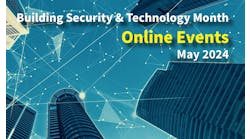The conversation around vertical transportation and uninterruptible power supplies often centers around efficiency and resilience, but there’s much more at stake with both of those systems—namely, the risk of major loss.
Bruce Peterson, the manager for the Pacific Northwest region in Mitsubishi Electric’s elevator/escalator division, and Aaron Schott, Mitsubishi Electric’s product manager for UPS solutions, join BUILDINGS editor-in-chief Janelle Penny to talk about the risks for commercial buildings. Listen now >>
[Start transcript]
Janelle Penny: Hi, this is Janelle Penny, editor-in-chief with BUILDINGS magazine. And today, I’m joined by Bruce Peterson, who is the manager for the Pacific Northwest region in Mitsubishi Electric’s elevator/escalator division, as well as Aaron Schott, who’s the product manager for UPS solutions. This podcast is created in partnership with Mitsubishi Electric.
Today, we’re going to be talking about the looming and potential financial risks with commercial building systems. Thanks for joining me, guys.
Bruce Peterson: Thank you.
Aaron Schott: Thank you.
Janelle: It seems like a lot of the conversation until now has been centered around things like efficiency and resilience when really the story behind both of those is trying to avoid loss. But there are different things at risk depending on whether the problem is inefficiency or downtime, right?
What is at stake in buildings as far as the risk of loss, and what are some of the things that could happen? Bruce, why don’t you take it first.
Bruce: Okay, well, thank you, Janelle. Elevators, I mean, there’s really a couple things that I think the building managers are at risk or property managers, building owners. One is unforeseeable, billable costs. That’s one thing that we hear quite often. What we mean by billable costs are just those callbacks that can happen with elevators when they’re shut down, and there’s a cost associated with that, when mechanics come out to fix them.
And quite often, the building owners just have not accounted for this cost. So, that’s certainly one risk. Another is with these billable callbacks, there’s employees within the property management firm that often get pulled in as well. And this takes time, from the property managers, building engineers, they need to work on these callbacks and that’s a cost to the building as well.
Then probably the last one would be just reputation. I mean, when elevators shut down, and they create a callback for the property management company, there’s also reputation at stake. And tenants get unhappy when elevators, and escalators for that matter, are not working properly. So, there’s that side of it as well.
Aaron: Yeah, I tend to agree that the risk of reputation is really a big deal for customers, especially in uninterruptible power supplies. And we’re all aware of all the different parts of a building that have to maintain operation, as you mentioned, elevators and escalators, but also with your own websites, all of the lights in the building, all the different parts and pieces where you need to have power up and running all the time, including medical equipment, and things along those lines.
If you have a customer that’s looking to buy something on your website, say you’re selling something through the internet, and they go to click, ‘Oh, I’d really like to buy that,’ but then all of a sudden your website crashes because you have a power outage, you have a big financial risk as well as the customer’s like, ‘Well, I didn’t have a really good experience with that website previously. And I might go to somebody else, to a different supplier, a different vendor.’
Same thing in a medical application where you have a scheduled patient that wants to come in, and has an MRI scheduled. They have a power outage at the hospital and next thing you know, they can’t come in for their MRI, or heaven forbid something else would go wrong, where you couldn’t have a surgical procedure available because your power is out.
UPSes are constantly backing those things up. And we look at the speed of which the market needs to respond, or customer wants something as really a reflection on our own sales as a company.
Janelle: Interesting. What are some of the risks that clients have approached Mitsubishi Electric with?
Bruce: What building owners want to be able to do it plan for their costs as much as possible. You know, whether it’s maintenance, repair or modernization, they want to be able to plan for those costs. And when you have emergency callbacks that come up with elevator equipment, which often lead into additional charges to building owners that are unplanned, that financial uncertainty I think is one of the big concerns that we hear from clients.
Also, there’s a safety risk when it comes to elevators. I mean, if elevators are not being maintained and serviced properly on an ongoing basis, I mean, there’s safety risks. If elevators are not functioning properly, escalators are not functioning properly, this could certainly be a potential hit to the public that’s riding on those elevators and escalators.
And then maybe one more for risk I think on clients is just in general slow response times. It’s one thing if an elevator is down and it takes a certain amount of time for a building repairman to get to that building to take care of that elevator.
But if there’s somebody entrapped in that elevator, that becomes a whole other situation. I mean, that really is a 911 emergency at that point. And response times are just critical. We have heard a lot from the property management community that sometimes their elevators are just not getting responded to in a timely manner. So, I think that’s also a potential risk.
Aaron: And you could imagine in a critical facility, as you mentioned, with entrapment in an elevator, it’s a 911 call for 911 call centers, their mission is critical for life safety of the public and all call centers like that are all backed up with the uninterruptible power supply. So, not only are the risks for a life if the facility goes down, they can’t receive the call, and they can’t dispatch the ambulance or things like that.
It’s also financial risks and the UPSes are used to support critical infrastructure in the financial industry, where the cost of a minute of downtime where the utility goes out and they can’t power their servers, they can’t process credit card transactions, you can’t buy equipment or parts and pieces or anything like that. The cost can be millions of dollars per minute of loss to a customer. Not only the financial risk of loss, but as we mentioned, your own name.
Janelle: Kind of on the same note, what are some of the most common problems or areas of risk that you see people having as someone who’s in this space? Whether that’s a client or just something you’ve noticed as somebody in the industry? Why don’t we start with vertical transportation.
Bruce: Yeah, so with elevators, there’s a couple things that are actually somewhat easy to address. But one of the things that I would mention to building owners and to have their staff address is door issues. One of the biggest reasons for callbacks on elevators are issues that are related to the doors. It’s people hitting them. I mean, that’s where really the contact is with the elevator for the people riding the elevators, I mean is at the doors.
One of the things is just as simple as the sills that the elevator doors ride in, just the tracks, I would highly recommend to building owners that they make sure that those are cleaned. Have their staff go out there and actually clean those on a regular basis. You’d be amazed at the number of times an elevator gets shut down just because it has debris accumulating in door tracks.
And then right along with that are the infrared door detectors that are the safety devices on the doors, but they are what when people come in, and if a person is walking through the door entrance, that’s what causes the doors to reopen is that infrared safety detector. Sometimes those can get built up with some dirt, dust and just on a regular basis, those should be cleaned.
Now, that’s something that the elevator mechanics as part of their service, they should be doing this. But I would also recommend to building management, that’s an easy way to potentially save yourself from potential billable callbacks. And they’re very easy to do.
Then another thing in the industry is just when it comes to safety, and even in particular as escalators, it’s very important that buildings have the safety signage that’s required out there. We’ve probably all seen this, but it shouldn’t happen and that’s children’s strollers on escalators. They shouldn’t do that. I mean, you should never have a child’s stroller on an escalator. It’s not safe.
And so, I think it’s important that building owners that have escalators as well make sure that that signage is out there. And then also for small children, small children should always be under the supervision of an adult. So, those are some things for the building management.
Then the other thing I would say to building owners is just to communicate with their elevator service company. Stay in communication, and obviously, that works both ways. But I think it’s very important for them to be discussing with their service company and their mechanics how their elevators and escalators are operating. Is everything going okay?
Also, it’s an opportunity for building owners to talk about future repairs, future modernizations that could be required or at least that the elevator company recommends for the elevator, if it’s a situation where the equipment is getting older. Then that allows the building owner to properly manage and plan for those kind of costs that they could be seeing out in the future.
Janelle: Great. Turning to uninterruptible power supplies, what are the big risks that you’re seeing out there? And what should our listeners know about solving their problems in that arena?
Aaron: Well, first off, with whether they have a UPS or not, understanding what level reliability and redundancy they need for their UPS is key to starting that conversation. Understanding what it means to them to have a minute of downtime, understanding that cost or an hour, several hours, because if you look at installations of UPSes.
A lot of times you’ll see a UPS put into a tiny little closet in a facility or it’s backing up something extremely important that someone has determined there’s a value associated with that, and then you go in there to do your general maintenance and you see that someone’s been stacking boxes on top of it or blocked all the airflow into the unit by putting something in front of it or storing a mop bucket next to it that is constantly wet.
So, in your facility, just ensuring that the area around the UPS is clean, and that’s a huge piece of powered equipment and any kind of dirt, debris and things like that can get stuck inside of the UPS and cause it to fail. So, with ensuring the cleanliness of the area and the environment which it’s in, it’s also having a really strong predictive maintenance routine performed on the UPS, where someone comes in semi-annually—or ideally at least semi-annually, but even sometimes quarterly just to come in, check on the UPS, make sure that, again, the environment’s clean, the unit is clean, it’s performing the way it should —all the alarms are off and nothing is going on.
But also to check and maintain the battery backup system for that UPS—whether it be some lead acid batteries in a little cabinet or a lithium-ion battery as we’re seeing kind of coming out in industry more recently—just ensuring that those batteries are able to support the UPS in the event of a critical outage.
It’s the most common point of failure in the UPS, is actually the battery system itself. Where you buy it day one, you install it, everything is great and backed up, everything’s reliable. Then five, six, seven years down the road, no one ever did any maintenance on the unit, no one ever checked the batteries.
So, those things can end up being the point of failure. The UPS is called upon during a power outage to do its job, to utilize its battery backup system to support your critical infrastructure, your servers or whatever you needed to support, and the batteries fail immediately because they haven’t been inspected or maintenance or are in need of replacement.
Janelle: So, we’ve talked a lot about different aspects of building systems today. What are the takeaways that you’d like listeners to remember? Or are there any keys that you can share to understanding either what risks are ahead, or how people listening can protect their buildings and their tenants from the potential consequences?
Bruce: Well, Janelle, with vertical transportation, I think one of the most key takeaways that I would give to the building owners that are listening out there, it’s a comprehensive, preventative maintenance program. With all of your vertical transportation, your elevators and escalators, I think that every building should have one. It should be in place and that I would recommend that the building owners understand it and what it’s all about.
The next key takeaway as I mentioned before but would be stay in close communication with your elevator service company. Ask questions. Always be looking for opportunities to have conversations with your elevator service company and just get an understanding of how the equipment is running. As I said before, I think that also gives a good opportunity to prepare and plan for future repairs and modernization to equipment that may be necessary.
Over years, equipment does age and it gets older and there are things that do need to take place as far as major repairs and/or possible upgrades to the equipment. So, I think it’s just important that they have that communication with their elevator service company, and then they can plan for it.
Probably then last is just vertical transportation, it’s extremely important. As I said before, it’s really the backbone to the building. When vertical transportation is running great, it’s the least of the building owner managers concerns.
Unfortunately, when it’s not running great, it quickly becomes probably their most important concern. What happens because of that, I mean, it almost goes without saying, but you have dissatisfied tenants. And that can, as I said before, that can quickly lead to a bad reputation. And in the short run, that can lead to tenant turnover.
But in the long run as a building owner, and I think even more important perhaps or equally important, I should say, is the potential if you ever want to sell the building. Whenever properties go up for sale, one of the first things that happens is they look at the vertical transportation, they look at the elevator equipment, often outside consultants are brought in to look at the equipment and it’s very, very important that that vertical transportation systems are up and running like they should be.
So, again, make sure that that comprehensive preventative maintenance program is in place and that your elevator service company is following it. That’s what I would say.
Janelle: Great.
Aaron: And I greatly agree with that. I mean, both elevators and UPS—it’s a long-term investment that you as a building manager have made to purchase a piece of equipment that you want to operate for as long as possible. And these aren’t always cheap decisions either. It’s not just like, ‘I bought a little boat I’m gonna sit on my desk. I think it’s gonna last 20 years, but if I have to replace it, it’s something simple.’
Replacing an elevator, even a large UPS could be very costly. So, the amount of maintenance and care you take to ensure that your equipment is running smoothly and operating for the future is the biggest takeaway I think you can take is the preventative maintenance, have it done at regular intervals, make sure you’re checking to make sure the environment that this equipment is operating stays clean, and that your batteries are performing well on your UPS, that they’re able to support your load.
And that way for the 20-plus years life expectancy of the UPS, you can ensure that it’s going to operate without fail, meeting all the needs of your customers, your facility and ensuring their uptime, as well as saving you money, making sure that the UPS is also a high efficiency.
Again, it’s a 20-plus year product. If you’re running at a lower efficiency because you’re not using the latest technology, then you’re stuck with that technology for 20 years. So, there’s efficiency standards increase, your LEED certification of your buildings, trying to set all those environmental, low loss initiatives of construction.
If you’re using a lower efficiency UPS, it may hurt you in the building design, but as well as, you’re going to have to pay for that year over year over year. So, having the highest efficiency UPS, and also maintaining it properly, so that it ensures the longevity of the site I think are biggest takeaways for UPS.
Janelle: Great. Well, thank you both so much for joining me today. And thanks to everybody out there for listening. This has been Janelle Penny, editor-in-chief for BUILDINGS magazine, and we’ll see you again soon.
Bruce: Thank you, Janelle.
Aaron: Thank you, everyone.
[End transcript]
Read more:


